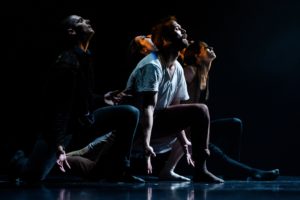Out Innerspace Dance Theatre: David Raymond and Tiffany Tregarthen / Bygones - Vancouver Ballet Society
- Home
- Reviews 2020 - 2023
- Out Innerspace Dance Theatre: David Raymond and Tiffany Tregarthen / Bygones

Dancers fall slowly, defying gravity; props move as if they have a mind of their own; walls of light slice through the haze, dividing the stage. In this fantasy world created by Out Innerspace co-artistic directors Tiffany Tregarthen and David Raymond, the boundaries are constantly shifting and the laws of physics don’t seem to apply. Cinematic and full of expressive, full-bodied movements, Tregarthen and Raymond’s choreography masterfully translates visual worlds from their imagination to the stage. This work is their most mature to date — the subject matter is more serious, the staging more complex and the collaborating dancers who join them onstage (Elya Grant, David Harvey and Renée Sigouin) are at the top of their game.
Developed over the course of several residencies, Bygones is a co-production of Montreal’s Agora de la danse and La Rotonde, and Dance Victoria. After its world premiere in October 2019 at One Dance Week festival in Bulgaria, the piece toured to Germany and Quebec before coming home to Vancouver’s Scotiabank Dance Centre in December.
Out Innerspace works have always played with lighting — using stark contrasts of light and dark to emphasize a particular dancer or movement — but this time around the lighting by James Proudfoot is a central element, creating pools of shadow, tunnels of light and walls the dancers pass through or hide behind. Obscuring as much as it illuminates, the lighting defines spaces, divides up the stage and adds to the mysterious quality of the fantasy world.
The eclectic soundtrack by Kate De Lorme is also striking and fits the personality of the onstage world very well.

As the audience fills the theatre, Tregarthen sits reading beside a small table. Everything is calm until a deep rumbling fills the space and dancers seem to fall from mid-air. Held by figures in black, the dancers fall slowly and smoothly as if suspended in water. Suddenly, Tregarthen’s book, the coffee cup on the table beside her and the flower pot at her feet all begin to move. She can’t control them, and the more she tries to contain the shaking, the more they move. Despite being able to see the strings connecting the objects to her, Tregarthen’s quick movements made it easy to suspend disbelief and it seemed as if the props moved by magic before being pulled offstage.
A parade of other various household objects such as a teapot, kettle and board game slide across the stage and leave Harvey in their wake. He rolls, flops and limply ambles around before crawling on the spot. In a later solo, Harvey’s lines and endless reaching added potent emotional depth. Elsewhere, Raymond’s precision and speed were captivating, Grant was measured and constant, while Sigouin and Tregarthen nimbly performed complex sequences while adding a calming presence.
With so much in flux, including mutable perspectives and shifting boundaries, striving for something better is a clear theme that runs throughout the work. When the objects from the very first scene reappear, they are in pieces and attached to each dancer, evoking themes of interconnection and recreation as the objects are deconstructed and rearranged. There are brief moments when the objects are whole as the dancers pause in a certain position before they carry on, suggesting that permanence is fleeting.
These themes reappear in the form of a mythical character about three quarters of the way in. Dressed in an eccentric white outfit and mask designed by mixed media artist Lyle Reimer using found and recycled objects, the creature could be better incorporated into the overall narrative arc.
After spending most of their time occupied by their own objectives and interests, the dancers come together in a cluster with a shared purpose around Harvey. This synchronized group sequence is all the more effective as it’s the first moment they are all onstage with a shared focus.
Along with running Out Innerspace and their Modus Operandi training program, Tregarthen and Raymond are members of Crystal Pite’s Kidd Pivot. Undoubtedly, their experience with Pite’s company performing in Betroffenheit and Revisor contributes to their own choreography. There are hints of Pite influences in the use of voiceover, the theatricality of their movement, and the clear themes and strong characters. Similar to Pite, they have a lot to say and their works efficiently convey a great deal of information while providing intelligent commentary on complex ideas.
Bygones is an ambitious work that succeeds in conveying its main theme: what’s bygone is bygone, but we still have the power to change the future.
— TESSA PERKINS DENEAULT

